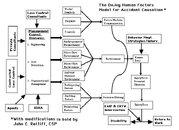I think I may have a few things to contribute here. First, let me say that I have been diving since 1959, and am a safety professional for over 30 years. Saying that, I have never before heard of the "Incident Pit" concept, and it is not discussed within professional safety circles. I have been a member of the American Society of Safety Professionals (ASSE) since the 1980s, and the American Industrial Hygiene Association (AIHA) for well over 10 years now, and neither of these organizations use the "Incident Pit" concept. This apparently was developed by British divers and diving physicians to explain things without consulting the safety profession itself.
But, the "Incident Pit" does explain the fears that our OP presents, of falling into the depths in limited visibility water. So let me address that right now, and get back to safety concepts in another paragraph.
Divers don't "fall." We float! However, modern divers have been sold on heavy steel tanks which contribute to divers being overweighted, and completely dependent upon their BC to be weightless. That didn't happen with the steel 72 cubic foot tank, which was as close to neutral buoyancy as a tank can be designed. If a diver starts out properly weighted, so that without air in the BC the diver is at eye level buoyant on fully inflated lungs, and only uses the BC to compensate for the loss of buoyancy of the wet suit, there should be no fear of "falling" in diving. We are essentially weightless, and "fly" in the water, buoyed by the water itself. We essentially, if properly weighted, cannot "fall." If a diver dives in this manner, there should be no fear of "falling" underwater.
Now, concerning the "Incident Pit," let me give some alternatives to this concept. First, let me explain the DeJoy Human Factors Model for Accident Causation, which I have depicted below. We know that virtually all accidents are the result of "human error." But how and why do we error? There are, in this model, three contributing areas to human error. They are "Person-Machine Communication," the "Environment," and "Decision Making." For each of these, there are other areas which feed into these three. You can take a look, and I won't completely elaborate because that would be beyond the scope of this post.
I will talk just a bit on the "Micro-Task Environment" and the "Macro-Task Environment," as these feed into the limited visibility situation we're discussing. The micro-task environment is that "stuff" immediately around the diver. This includes how the equipment the diver is using is fitted (actually "anthropology/biomechanics), the use of gloves, a mask with limited field of vision, the water not allowing full visual representation, etc. The macro-task environment would be how the diver fits into the total environment around him or her. Again, the limited visibility allows disorientation of the diver, and if in a river, the currents can cause a person in limited visibility to get "turned around" (which is why a compass comes in very handy in limited visibility).
The "Decision-Making" process comes into effect in limited visibility, as already there is a "predisposing factor" of anxiety because of the colder water and the limited visibility. This is where dive planning comes in very handy. You have heard it said, "Plan your dive, and dive your plan." But at times, especially in limited visibility, you need to be able to improvise when the "plan" comes somewhat unwound (disorientation, loss of buddy contact, etc.). These things need to also be planned for, and the divers need to surface and re-group if buddy contact is lost. Or, hand-holding or a buddy line can be employed to ensure buddy contact is not lost.
These are the control factors under the "Management Control Strategies" section of this diagram. I won't go further because this is already pretty long.
I will say that accepted accident investigation techniques include what is called the "Fault Tree Analysis" (where the "fault" is a system fault, and not blaming someone for a "fault"). One of the other that we have used (there are several more) professionally is the Five Why Analysis. It is beyond this post to explain these, but I do feel that the "Incident Pit" concept gives divers the wrong feeling, that of "falling into the pit" rather than floating and figuring out what is happening, determining how to cope with those happenings, and ascending to the surface. NetDoc was onto something when he discussed buoyancy above.
SeaRat
John C. Ratliff, CSP, CIH, MSPH
NAUI #2710 (long ago retired)





